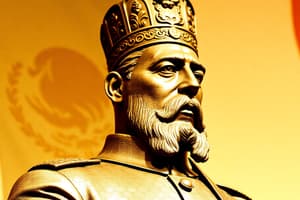Podcast
Questions and Answers
Which of the following best describes Porfirio Díaz's approach to maintaining political stability in Mexico during the Porfiriato?
Which of the following best describes Porfirio Díaz's approach to maintaining political stability in Mexico during the Porfiriato?
- Promoting complete isolationism to protect Mexico from foreign influence and interference.
- Establishing a socialist state to equally distribute wealth and land among the population.
- Encouraging conflict among local leaders, strengthening the military, and censoring dissent. (correct)
- Implementing democratic reforms that allowed for free and fair elections at all levels of government.
How did Porfirio Díaz manage to garner and maintain the support of the Catholic Church, a group previously at odds with the Mexican government?
How did Porfirio Díaz manage to garner and maintain the support of the Catholic Church, a group previously at odds with the Mexican government?
- Forcibly seizing church assets and persecuting religious leaders to eliminate their influence.
- Implementing strict anti-clerical laws that severely restricted the Church's activities.
- Adopting a conciliatory approach towards the Church, a departure from the policies of his predecessors. (correct)
- Ignoring the Church completely, focusing instead on secularizing Mexican society.
What was the primary role of 'the scientists' (los científicos) during the Porfiriato?
What was the primary role of 'the scientists' (los científicos) during the Porfiriato?
- To advocate for radical social reforms and land redistribution to benefit the peasantry.
- To lead opposition movements against Díaz's authoritarian rule and advocate for democracy.
- To promote Positivist ideas that justified the government's actions as necessary for national progress. (correct)
- To manage and control the economic development brought on by foreign investors.
What was a key difference in the management of railroad construction during the Porfiriato?
What was a key difference in the management of railroad construction during the Porfiriato?
How did economic development during the Porfiriato affect the distribution of wealth and social equality in Mexico?
How did economic development during the Porfiriato affect the distribution of wealth and social equality in Mexico?
Despite efforts to expand education, what was a significant limitation of education during the Porfiriato?
Despite efforts to expand education, what was a significant limitation of education during the Porfiriato?
Which factor significantly contributed to growing public discontent in the later years of Porfirio Díaz's regime?
Which factor significantly contributed to growing public discontent in the later years of Porfirio Díaz's regime?
What role did the rurales (rural guards) play in Porfirio Díaz's strategy for maintaining order?
What role did the rurales (rural guards) play in Porfirio Díaz's strategy for maintaining order?
The economic system of haciendas during the Porfiriato was characterized by which of the following?
The economic system of haciendas during the Porfiriato was characterized by which of the following?
Which of the following best describes the political state of Mexico towards the end of the Porfiriato?
Which of the following best describes the political state of Mexico towards the end of the Porfiriato?
Flashcards
The Porfiriato
The Porfiriato
The 35-year period (1876-1911) of authoritarian rule by General Porfirio Díaz in Mexico, marked by peace, order, and economic modernization.
Porfirio Díaz
Porfirio Díaz
Military figure who became president of Mexico in 1876 and maintained power through strategic alliances, censorship, and repression.
Pacification Strategy
Pacification Strategy
Díaz's strategy of encouraging local leaders to fight each other, then strengthening the army and police to control the countryside.
"The Scientists"
"The Scientists"
Signup and view all the flashcards
Economic Development During Porfiriato
Economic Development During Porfiriato
Signup and view all the flashcards
Regional Economic Activities
Regional Economic Activities
Signup and view all the flashcards
Social Challenges
Social Challenges
Signup and view all the flashcards
Economic Crisis (1907-1908)
Economic Crisis (1907-1908)
Signup and view all the flashcards
Landowner Support
Landowner Support
Signup and view all the flashcards
Education Expansion
Education Expansion
Signup and view all the flashcards
Study Notes
The Porfiriato (1876-1911)
- General Porfirio Díaz governed Mexico for 35 years.
- The Porfiriato was interrupted only by Manuel González's brief presidency.
- The period was known for authoritarian rule
- Peace, order, and economic modernization initiatives characterized the era.
Porfirio Díaz's Rise to Power and Political Strategies
- Porfirio Díaz was a military figure during the French intervention in Mexico.
- Díaz assumed power in 1876, after political instability.
- Díaz pacified the country by inciting local leaders to fight each other.
- He strengthened the army and police to control the countryside.
- Rural guards were employed in this effort.
- The government centralized power more effectively than any since independence.
- Peace and order were maintained through censorship and repression.
- Such policies were viewed as the price for stability.
- Díaz repeatedly modified the constitution to allow his re-election as president.
Alliances and Support Base
- Díaz strategically allied with powerful social groups.
- He adopted a conciliatory approach to the Church, unlike his predecessors.
- He gained the support of landowners by allowing private exploitation of vacant and indigenous lands.
- Politicians and intellectuals known as "the scientists" promoted Positivist ideas.
- These ideas justified the government's actions as necessary for national progress.
Economic Development During the Porfiriato
- Mexico experienced economic development under Díaz, opening the country to foreign investors, especially from Britain and the U.S.
- Railroad construction was incentivized, largely by foreign companies, and later managed by the Mexican state from 1907.
- Between 1877 and 1910, Mexico's foreign trade increased significantly.
- The U.S. became its main trading partner.
- Key exports included minerals like copper, zinc, silver, and gold.
- Limited industrialization occurred, focused on textiles, cement, and iron.
Regional Economic Disparities
- Economic development varied across Mexico.
- Mining occurred in the north.
- Agriculture in the central valley focused on wheat and grains.
- Sugar cane was produced in Morelos.
- Henequen plantations existed in Yucatán.
- Natives were forced to work as laborers in Yucatán.
Social Conditions, Education, and Challenges
- Economic growth benefited a small segment of the population.
- Most Mexicans had low wages and lived in poverty.
- The government expanded secular, public, and mandatory education.
- Education had limited reach in rural areas.
- Only about 25% of the population could read and write.
- As Porfirio Díaz's regime grew older, it faced growing problems.
- Social inequalities led to strikes and protests.
- Emerging political groups advocated for democracy.
- An economic crisis between 1907 and 1908 led to mass layoffs and wage reductions.
- Bad harvests worsened conditions, increasing public discontent.
- Mexico was becoming ripe for a revolution.
Studying That Suits You
Use AI to generate personalized quizzes and flashcards to suit your learning preferences.




